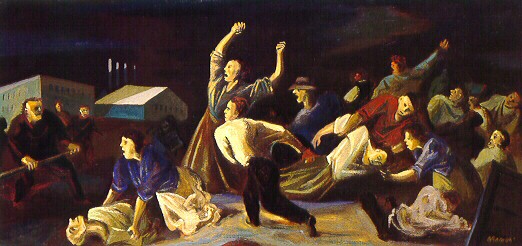

WILLIAM GROPPER 1897-1977
Youngstown Strike, c.
1937
Oil on canvas, 20 X 40" (50.80 x 10 1. 60 cm.)
Signed, lower right
Museum purchase, 985-0-106
During the years of the Great Depression, industrial strikes and incidents of
strikebreaking occurred across the country, especially in the coal mining and steel
production centers. Indeed, this was a time when social unrest had spread to all trades
and crafts throughout America. By the mid-1930s, the nation had suffered more than 2,000
strikes.1 It is understandable, then, that the strike theme appeared so frequently in the
art produced by socially- conscious artists of the period.
New York artist William Gropper, who was actively engaged in support of the organized
labor movement throughout his career, produced some of the most gripping social protest
works of the period. Youngstown Strike is one of Gropper's most compelling
works, apparently prompted by the extended strikes staged in 1936-37 by workers at the
Youngstown Sheet and Tube Company, Youngstown, Ohio. During these years chaos frequently
reigned throughout much of the city. In one incident, following a savage confrontation
with police guards by workers and their families, the police tear gassed and shot at the
workers; two strikers were killed and twenty-eight injured. Gropper visited Youngstown
during this period, and commented on the incident in an article and a series of
descriptive action sketches published in The Nation.
What is particularly significant, however, is the fact that this painting depicts not
the 1937 strike, but rather a similar incident that occurred in an early 1916 steel strike
in Youngstown. This fact reflects the long-term commitment of Gropper, and of many other
artists of the Great Depression, to depict past incidents that could logically serve to
illustrate primary causal forces for the social disruptions of the 1950s.
The 1916 strike at the Youngstown Sheet and Tube plant was declared on January 6 by the
8,000 employed workers, seemingly as a result of wage demands as well as the employees
wretched housing conditions ' On the following day, January 7,'the strikers' wives and
other members of their families joined in protest outside the factories. In an attempt to
disperse them, company guards employed tear gas bombs and thereafter fired into the crowd;
three strikers were killed and twenty-five others were wounded. Gropper's painting depicts
the chaotic moment immediately after the shootings when the dead workers are lying on the
ground and the shocked crowd expresses its outrage at the atrocity. The similarity between
the conditions which led to this tragedy and those which had continued to prevail during
the ensuing decades constituted Gropper's message of anger and dismay at this crucial
moment.
In portraying this 1916 incident twenty years after it had occurred, Gropper demonstrated
his active sympathy for the cause of American labor. Indeed, Gropper apparently looked
upon the incident of 1937 as a replay of the 1916 strike. In painting Youngstown Strike
in 1937, he portrayed the workers of 1916 and their families as if they had returned
from the past to re-enact their tragedy, reminding the viewer, as well as the exploited
laborers themselves, of the falsity of management's assurances. The movements of the
excited figures appear artificial, yet it is by the use of such rhetorical gestures that
Gropper could best express his outrage. At the same time, the figural organization, the
strong colors, the body gestures and facial expressions, the powerfully bright light,
abruptly contrasting with the almost black background and, above all, the heavy impasto
with its energetically restless movement, effectively echo the miasmic diabolism of the
incident, and the suffering and desperation of the period. Youngstown Strike is a
powerful work that forcefully communicates the mood of despair which so characterized the
Great Depression.
HOWARD E. WOODEN